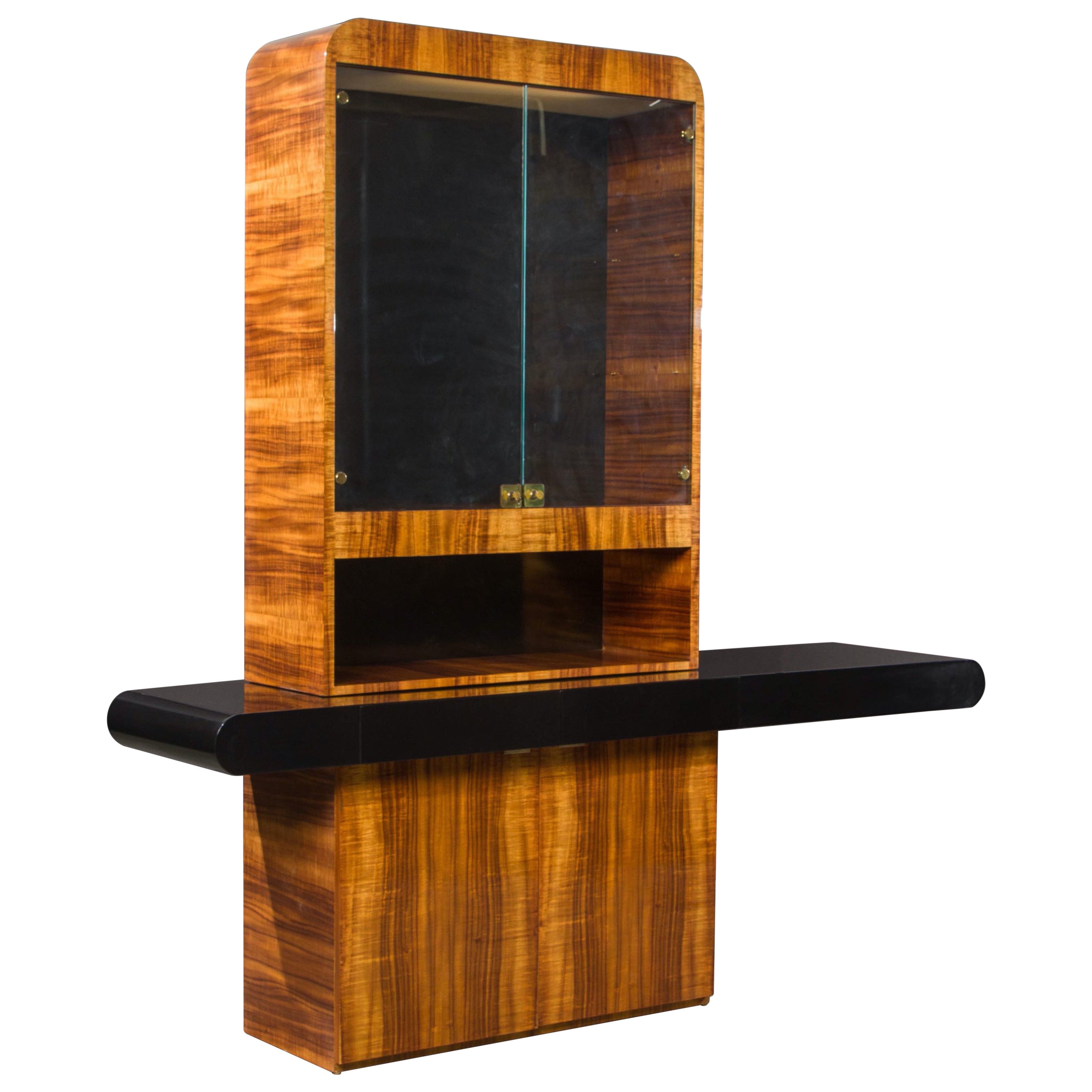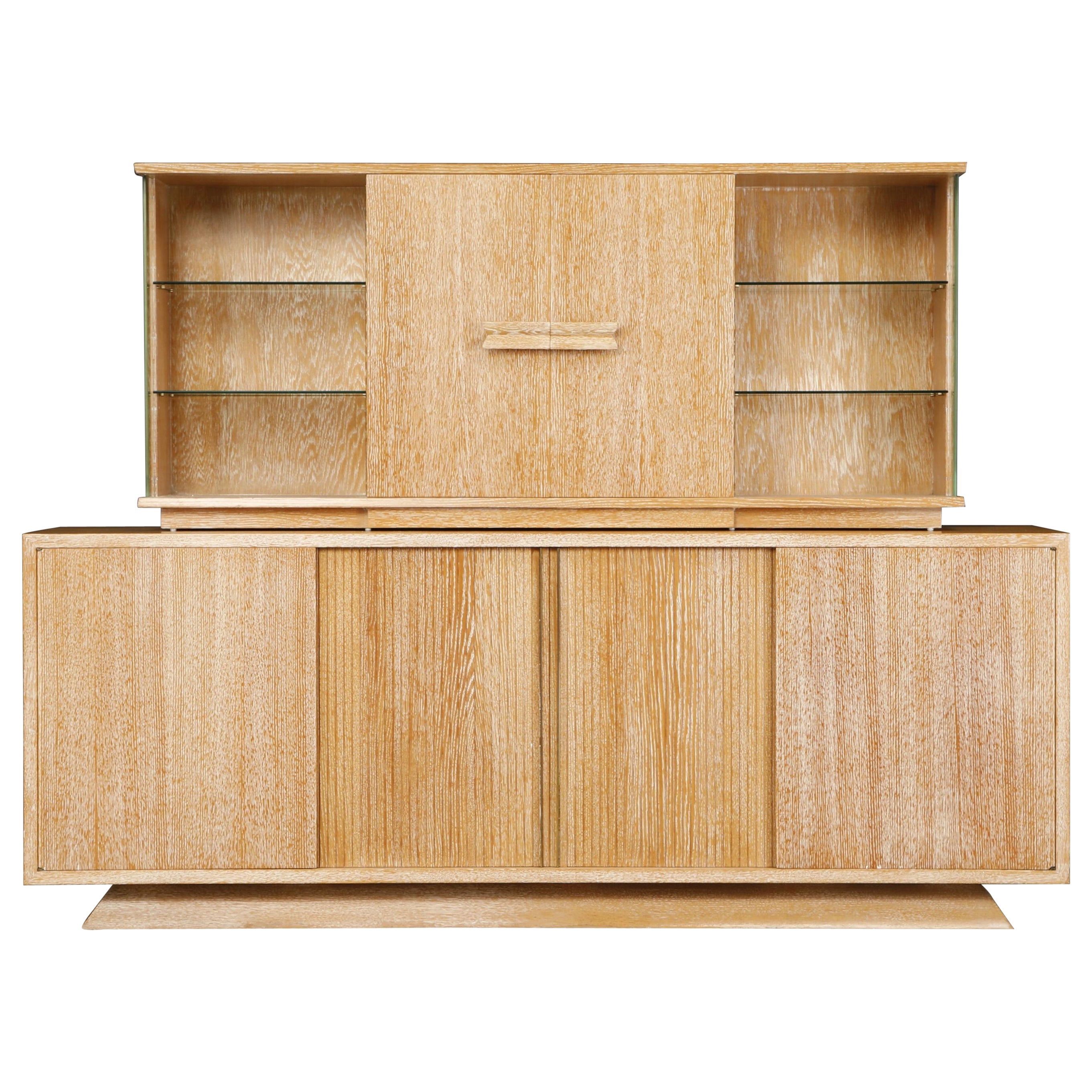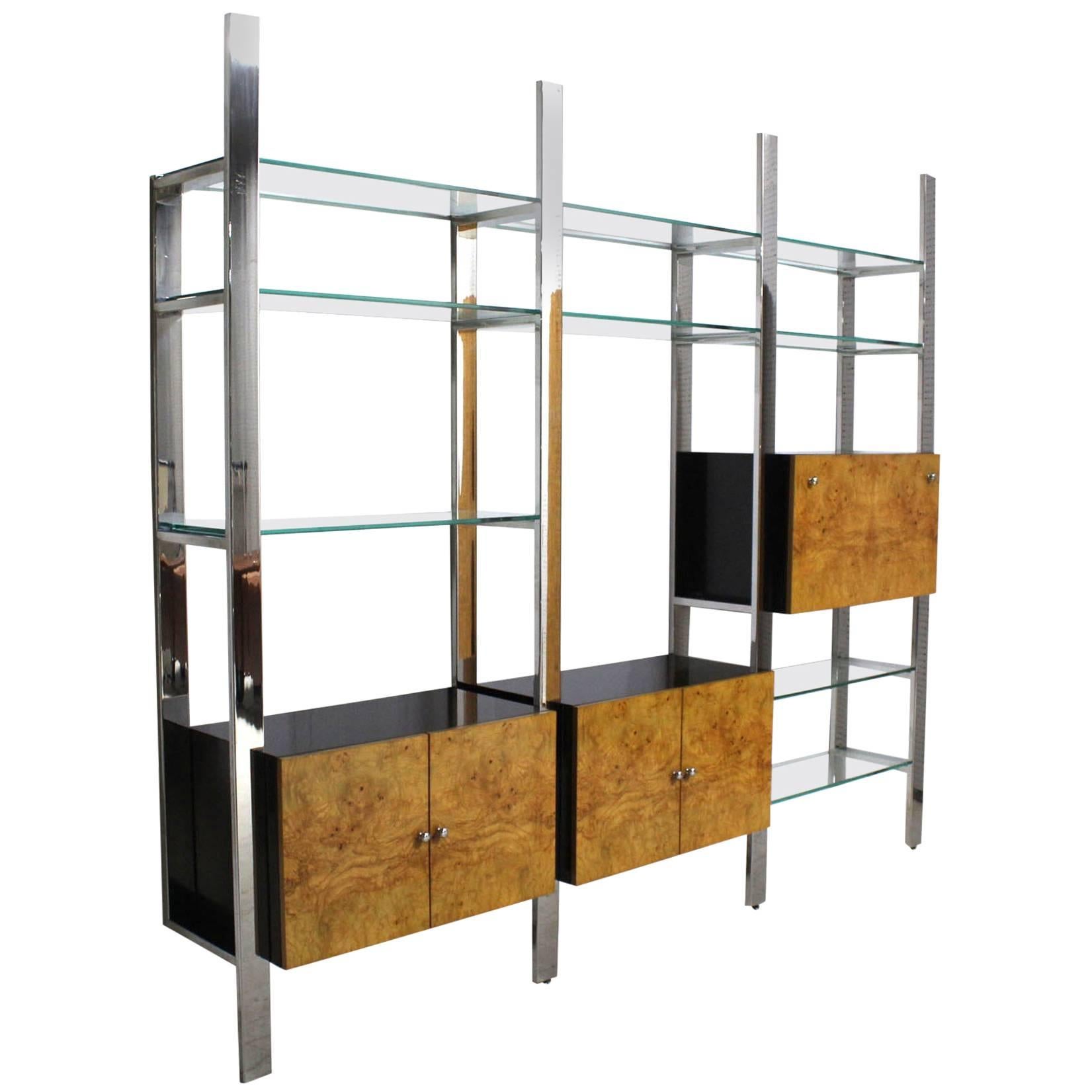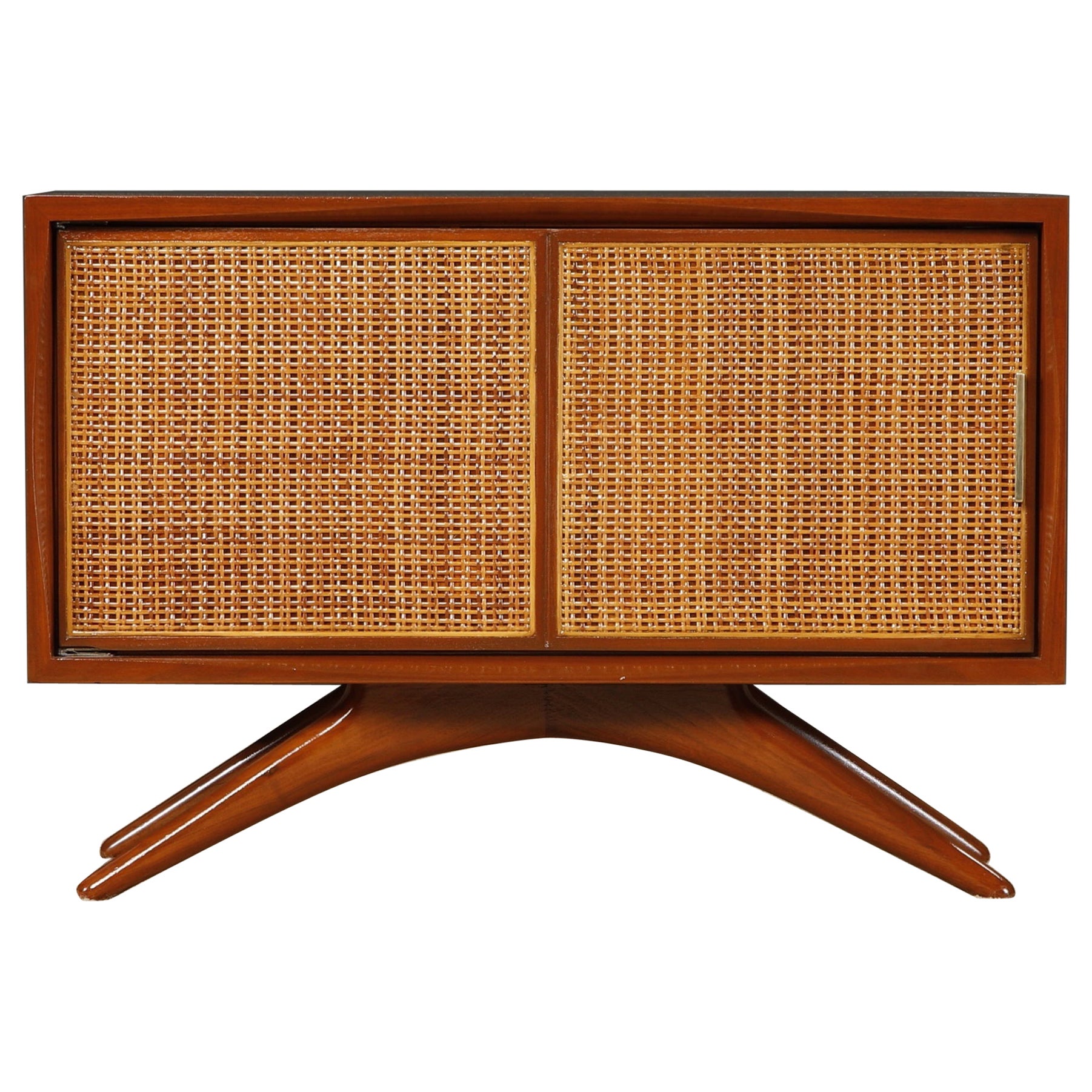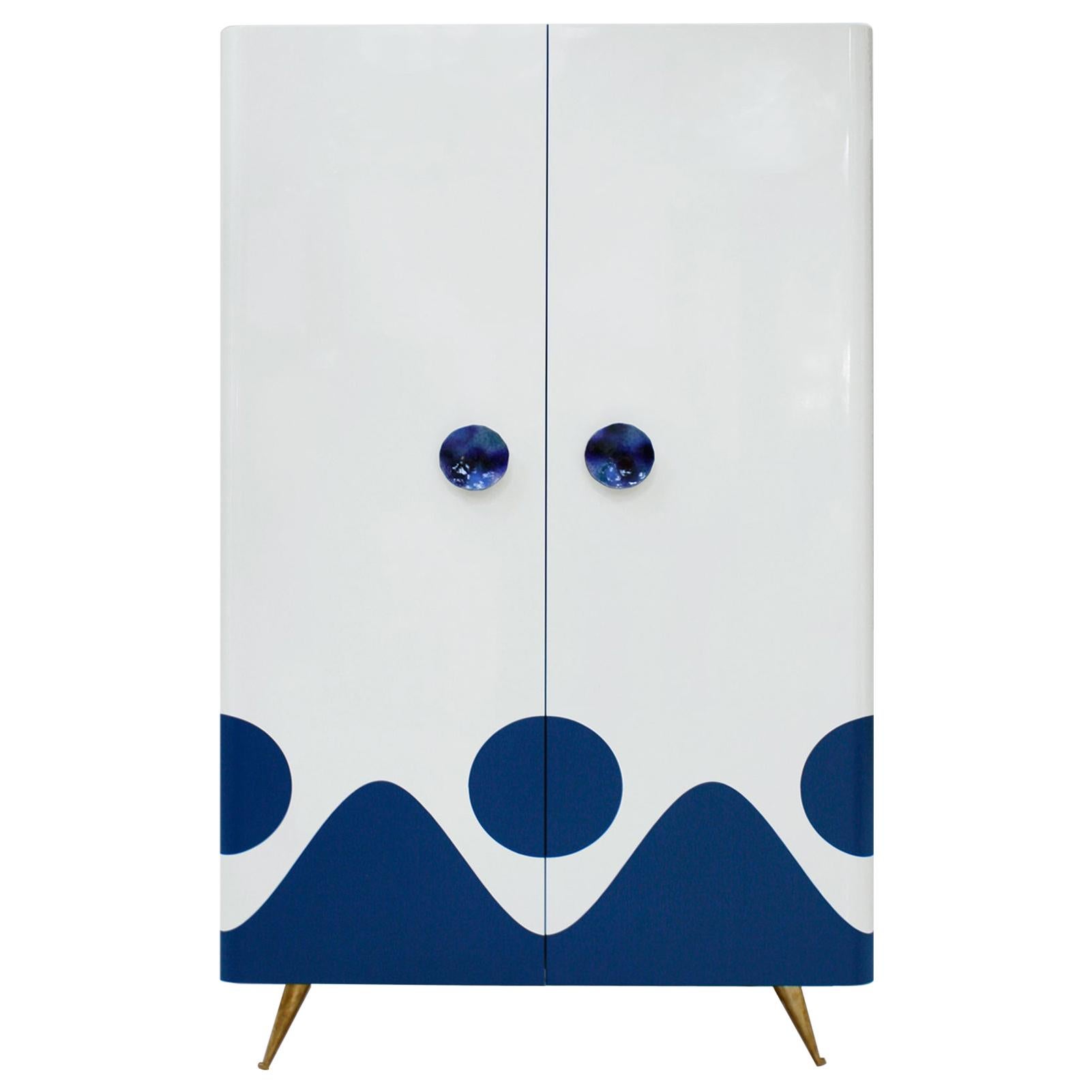Vladimir Kagan Burl Wood Wall Unit Cabinet Sideboard
About the Item
- Creator:Vladimir Kagan (Designer)
- Similar to:Milo Baughman (Designer)
- Dimensions:Height: 96 in (243.84 cm)Width: 108 in (274.32 cm)Depth: 20 in (50.8 cm)
- Style:Mid-Century Modern (Of the Period)
- Place of Origin:
- Period:
- Date of Manufacture:circa 1970s
- Condition:Wear consistent with age and use.
- Seller Location:Rockaway, NJ
- Reference Number:1stDibs: LU88375436353
Vladimir Kagan
The pioneers of modern furniture design in America in the mid-20th century all had their moments of flamboyance: Charles and Ray Eames produced the startling, biomorphic La Chaise; George Nelson’s firm created the Marshmallow sofa; Edward Wormley had his decadent Listen to Me chaise. But no designer of the day steadily offered works with more verve and dynamism than Vladimir Kagan. While others, it seems, designed with suburban households in mind, Kagan aimed to suit the tastes of young, sophisticated city-dwellers. With signature designs that feature sleekly curved frames and others that have dramatic out-thrust legs, Kagan made furniture sexy.
Kagan’s father was a Russian master cabinetmaker who took his family first to Germany (where Vladimir was born) and then to New York in 1938. After studying architecture at Columbia University, Kagan opened a design firm at age 22 and immediately made a splash with his long, low and sinuous Serpentine sofa. Furniture lines such as the Tri-symmetric group of glass-topped, three-legged tables and the vivacious Contours chairs soon followed.
Kagan’s choices of form and materials evolved through subsequent decades, embracing lucite, aluminum and burl-wood veneers. By the late 1960s, Kagan was designing austere, asymmetrical cabinets and his Omnibus group of modular sofas and chairs. For all his aesthetic élan, Kagan said that throughout his career, his touchstone was comfort. “A lot of modern furniture was not comfortable. And so comfort is: form follows function. The function was to make it comfortable,” he once commented. “I created what I called vessels for the human body.”
A diverse group of bodies have made themselves at home with Kagan designs. Among the famous names who commissioned and collected his designs are Marilyn Monroe, Gary Cooper, Andy Warhol, David Lynch, Angelina Jolie and Brad Pitt, and firms such as Gucci and Giorgio Armani. His work is in numerous museum collections, including those of the Victoria & Albert and the Metropolitan Museum of Art.
Because of its idiosyncrasy, Kagan’s work did not lend itself to mass-production. Kagan never signed on with any of the major furniture-making corporations, and examples of his designs are relatively rare. As you will see from the offerings on 1stDibs, even decades after their conception, Kagan pieces still command the eye, with their freshness, energy, sensuality and wit.
- ShippingRetrieving quote...Ships From: Hardwick, NJ
- Return PolicyA return for this item may be initiated within 1 day of delivery.
- Burl Wood Thick Glass Shelves 3 Bay Wall UnitBy Pace Collection, Milo BaughmanLocated in Rockaway, NJMirror chrome polished stainless steel frame, burl wood cabinets, thick glass shelves Mid-Century Modern wall unit. Secretary drop desk compartment....Category
20th Century American Mid-Century Modern Vitrines
MaterialsStainless Steel, Chrome
- Large Mid Century Modern Multi Tear Level Shelf Wall Unit EtagereBy Milo BaughmanLocated in Rockaway, NJVery nice Mid-Century Modern shelf wall unit.Category
20th Century American Mid-Century Modern Shelves
MaterialsChrome
- Tall High Gloss Lacquer Finish Rounded Beveled Glass Display Cabinet Wall UnitBy Jay SpectreLocated in Rockaway, NJHigh quality Mid-Century Modern display qurio cabinet. High gloss durable finish, rounded beveled glass panels, brass hardware and base, two display lights, 87" tall.Category
20th Century American Mid-Century Modern Shelves
MaterialsHardwood
- Mid-Century Modern Five Shelves Chrome and Glass Shelving Unit ÉtagèreBy Milo BaughmanLocated in Rockaway, NJMid-Century Modern Milo Baughman style chrome all welded stainless steel étagère.Category
20th Century American Mid-Century Modern Shelves
MaterialsChrome
- 5-Tier Lucite and Glass Mid-Century Modern Étagère Shelf Wall UnitBy Charles Hollis JonesLocated in Rockaway, NJMid-Century Modern Lucite and glass tall narrow shelving unit étagère.Category
20th Century American Mid-Century Modern Shelves
MaterialsAluminum
- Chrome and Glass Large Design Institute America Étagère Shelving Wall UnitBy Design Institute AmericaLocated in Rockaway, NJMid-Century Modern large chrome and glass étagère shelving wall unit.Category
20th Century American Mid-Century Modern Vitrines
MaterialsChrome
- Vladimir Kagan Exotic Wood Illuminated Sideboard Bar Cabinet, c 1970s, SignedBy Vladimir KaganLocated in Los Angeles, CAThis impressive Vladimir Kagan for Vladimir Kagan Designs illuminated sideboard and hutch cabinet, in an exotic wood with incredible wood grain was...Category
Vintage 1970s American Post-Modern Sideboards
MaterialsBrass
- Important Cerused Oak Sideboard by Vladimir Kagan for Kagan-Dreyfuss, SignedBy Kagan-Dreyfuss, Inc., Vladimir KaganLocated in Los Angeles, CAThis important piece of design history was not only designed by Vladimir Kagan and handcrafted by Kagan-Dreyfuss in circa 1949 New York... this was also owned by Kagan himself and kept throughout his entire adult life (see provenance notes below). Each of the two pieces (lower credenza and upper dry bar / hutch) are signed on the back with Kagan-Dreyfuss New York stamps. The expansive size provides exceptional storage and use options. Kagan-Dreyfuss (Vladimir Kagan's partnership with Hugo Dreyfuss from circa 1950-1960) stamped pieces are amongst the most sought after by collectors and investors of art and design. Furniture with Kagan-Dreyfuss stamps are extremely hard to find and demand exceptional value, and this credenza with hutch is double stamped (one on each piece). Featuring a cerused oak exterior, with tambour doors on the lower credenza, sculpted handles (which slide to reveal a keyhole, no key is present however can be rekeyed) on the upper hutch...Category
Vintage 1940s American Mid-Century Modern Sideboards
MaterialsGlass, Mirror, Formica, Oak
- Caned Sculptural Cabinet by Vladimir Kagan for Grosfeld House, 1950s, SignedBy Vladimir Kagan, Grosfeld HouseLocated in Los Angeles, CAThis very rare sculptural caned cabinet was designed by Vladimir Kagan and crafted by Grosfeld House during the 1950s in New York, documented in early Grosfeld House advertisements (...Category
Vintage 1950s American Mid-Century Modern Cabinets
MaterialsWalnut, Cane
- Milo Baughman Style Henredon Scene Two Burl Wood Bar Display Cabinet Wall UnitBy HenredonLocated in Philadelphia, PAThree-part lighted China, cabinet or bar from the scene two collection by Henredon. This stunning unit features shapely Art Deco form, mirrored back, slide out bar surface, patch wor...Category
Vintage 1970s American Mid-Century Modern Cabinets
MaterialsBurl, Glass
- L.A. Studio Lacquered White Wood Paolo De Poli Handles Italian Drinks CabinetBy L.A. StudioLocated in Ibiza, SpainDrinks cabinet designed and produced by L.A. Studio made of solid wood structure with high gloss lacquered surface in white with blue details. Inside clad in Bubinga wood and inside ...Category
21st Century and Contemporary Spanish Modern Dry Bars
MaterialsMarble, Brass, Bronze
- Cesare Lacca Italian Midcentury Bar Display CabinetBy Cesare LaccaLocated in bari, ITBar display cabinet made in Italy from the 1950s, designer Cesare Lacca.Category
Vintage 1950s Italian Mid-Century Modern Dry Bars
MaterialsBrass
Recently Viewed
View AllRead More
Martyn Lawrence Bullard Welcomes You to the Hotel Californian
A Spanish Colonial Revival gem in the heart of Santa Barbara has been reborn as a luxurious new boutique hotel.
Rooms We Love: 11 Splendid Living Rooms
Common wisdom used to declare the kitchen the hub of the house. These days, the living room seems to have assumed the role of domestic focal point. Unlike the Victorian parlor, stiffly furnished and reserved for guests, today’s living room is a central place for reading, conversation and, well, living, with furnishings that lend themselves to both casual lounging and elegant entertaining.
